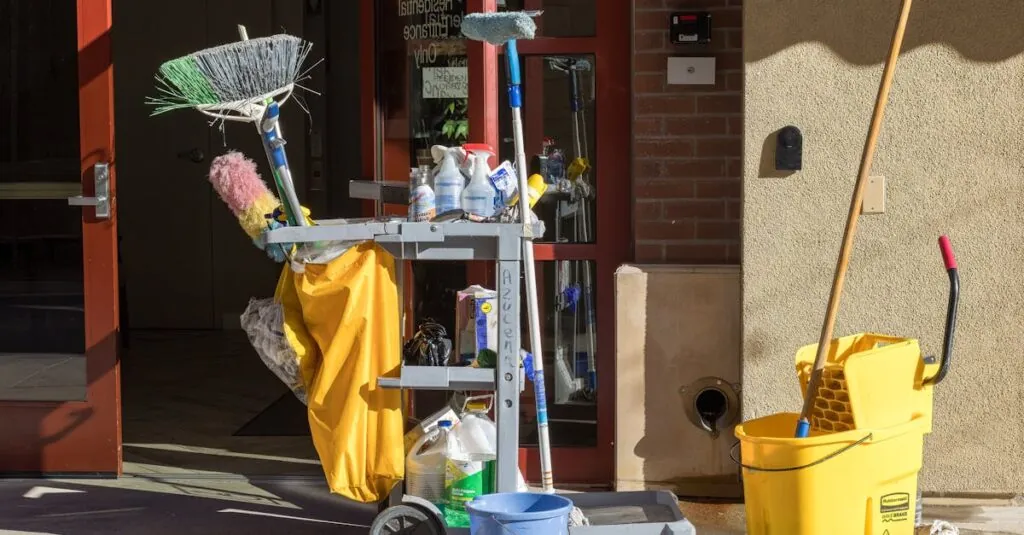Keeping a clean space isn’t just about aesthetics; it’s about creating an environment that promotes productivity and well-being. Imagine walking into a sparkling room where everything’s in its place, and the air smells fresh enough to inspire a Broadway musical. With a solid cleaning maintenance checklist, that dream can be a reality.
Think of this checklist as your trusty sidekick in the battle against dust bunnies and clutter. It’s not just a list; it’s a game plan that turns chaos into calm. From wiping down surfaces to tackling those forgotten corners, this guide ensures nothing gets left behind. So grab your favorite cleaning supplies and let’s dive into the world of spotless spaces—because a clean home is a happy home, and who doesn’t want a little more happiness?
Table of Contents
ToggleImportance Of A Cleaning Maintenance Checklist
A cleaning maintenance checklist streamlines the cleaning process, ensuring tasks aren’t overlooked.
It fosters accountability, making it easier for individuals or teams to track their cleaning efforts. Consistency emerges as a key benefit, allowing regular upkeep of spaces, which promotes a healthier environment.
Productivity increases when spaces remain clutter-free and organized. Retaining cleanliness minimizes distractions, enabling focus on important tasks. Clutter creates stress, making it vital to have a systematic approach.
Encouragement for teamwork is another advantage. Sharing the checklist among household members or coworkers cultivates a sense of responsibility, thereby enhancing collaboration. Frequent evaluations lead to identifying areas that require more attention.
Using a cleaning maintenance checklist also facilitates effective time management. By prioritizing tasks, individuals allocate time wisely, tackling the most critical areas first. This strategized approach results in tidier spaces in shorter time frames.
Promoting sustainability is another important aspect. Regular cleaning often limits the need for extensive or harsh cleaning products. Maintaining clean environments enhances aesthetic appeal, which speaks to professionalism in workplace settings.
A cleaning maintenance checklist enhances overall organization, accountability, and efficiency. It serves as a practical tool for creating inviting, healthy spaces that contribute to overall well-being.
Key Components Of A Cleaning Maintenance Checklist
A cleaning maintenance checklist includes essential tasks categorized by frequency. Organizing these tasks promotes efficiency and ensures that nothing gets overlooked.
Daily Cleaning Tasks
Daily cleaning tasks maintain a tidy space. Wiping down surfaces, including countertops and desks, reduces dust and grime. Emptying trash bins prevents unpleasant odors from developing. Vacuuming or sweeping high-traffic areas maintains cleanliness and reduces allergens. Additionally, sanitizing bathrooms stops the spread of germs. Delegating these tasks among household members or coworkers fosters collective responsibility while enhancing accountability.
Weekly Cleaning Tasks
Weekly cleaning tasks help uphold overall cleanliness. Vacuuming carpets and rugs removes embedded dirt and allergens, improving air quality. Mopping hard floors eliminates buildup and enhances shine. Dusting furniture, including shelves and electronics, keeps surfaces fresh and appealing. Cleaning kitchen appliances, such as microwaves and refrigerators, ensures food safety and hygiene. Scheduling these tasks fosters a routine that prevents overwhelming workloads.
Monthly Cleaning Tasks
Monthly cleaning tasks focus on deeper cleaning opportunities. Washing windows enhances natural light and improves visibility. Cleaning behind and beneath large furniture prevents dust accumulation and pests. Sanitizing high-touch areas, such as light switches and doorknobs, promotes health and cleanliness. Organizing storage spaces optimizes accessibility and reduces clutter. Regularly completing these tasks creates a healthier living or work environment.
Benefits Of Using A Cleaning Maintenance Checklist
Using a cleaning maintenance checklist enhances organization in both home and workplace settings. It systematically outlines tasks, preventing any from being overlooked. Increased productivity often results from having a clear plan for cleaning efforts. Many individuals find that breaking down tasks into daily, weekly, and monthly categories fosters accountability.
Furthermore, the checklist supports teamwork and collaboration, encouraging all members of a household or team to participate in maintaining cleanliness. Structured roles within the list promote shared responsibility and make cleaning less burdensome. This division often leads to a more organized environment as everyone knows their tasks.
Stress reduction also occurs when spaces remain clutter-free and tidy. Clean environments minimize distractions, allowing individuals to focus better on their work or personal activities. Regularly completing these outlined tasks contributes significantly to overall health and wellness.
In addition, a cleaning maintenance checklist can promote sustainability by reducing reliance on harsh cleaning supplies. Using less aggressive products fosters a safer atmosphere, which benefits both health and the environment. The visual appeal of tidy spaces enhances professionalism, especially in workplace settings.
A well-maintained space influences mental clarity and relaxation, further supporting overall well-being. Thus, a cleaning maintenance checklist serves not only as an organizational tool but also as an essential element for fostering inviting and healthy environments.
Tips For Effective Implementation
Establishing a routine enhances the effectiveness of a cleaning maintenance checklist. Regularly scheduled tasks create predictability in cleaning efforts, prompting everyone to participate. Assigning specific tasks to individuals fosters accountability, ensuring that all responsibilities are clear.
Utilizing the checklist during team meetings reinforces collective commitment to cleanliness. Clarity in task distribution leads to efficient execution, minimizing confusion. Tracking progress with status updates provides motivation and celebrates completed tasks, creating a sense of accomplishment.
Integrating reminders through digital tools aids in keeping cleaning tasks top-of-mind. An app or shared calendar allows for real-time updates and enhances coordination. Visual aids, such as charts or graphs tracking progress, can also inspire motivation and engagement.
Revisiting the checklist periodically ensures it remains relevant. Adapting tasks to changing needs maintains efficacy and keeps everyone invested. Encouraging feedback from all participants invites continuous improvement in the cleaning process.
Evaluating the impact of a clean environment reinforces the importance of maintaining high standards. Enhanced productivity often follows a regular cleaning routine, leading to better focus and less stress.
Celebrating achievements, whether big or small, creates a positive atmosphere that encourages ongoing participation. Sharing success stories or visuals of clean spaces fosters pride in the efforts made.
Promoting teamwork during cleaning tasks reinforces collaboration among all members involved. Effective communication during cleaning can reveal insights on optimizing processes, ensuring everyone’s voice is heard.
Conclusion
Embracing a cleaning maintenance checklist can significantly enhance the quality of living and working environments. By establishing a routine and tracking tasks, individuals foster accountability and promote a sense of teamwork. This not only minimizes clutter but also boosts productivity and reduces stress.
Implementing the checklist encourages a proactive approach to cleanliness, ensuring that every corner is attended to. As spaces become more organized and inviting, the positive impact on well-being becomes evident. With consistent effort and a commitment to maintaining high standards, achieving a spotless and serene environment is within reach.





